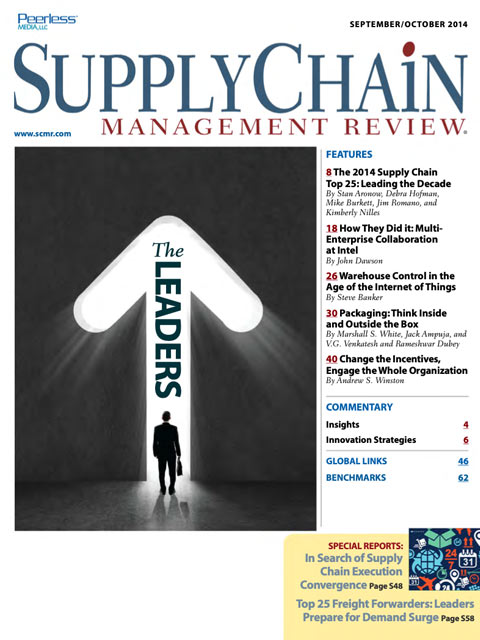Sorry, but your login has failed. Please recheck your login information and resubmit. If your subscription has expired, renew here.
September-October 2014
2014 marks the 10 year anniversary of the Gartner Supply Chain Top 25 ranking. This year we have a diverse set of large, global companies with mature, demand-driven supply chains. There are lessons to be learned from these supply chain leaders, many of whom have led their industries over the past decade. Browse this issue archive.Need Help? Contact customer service 847-559-7581 More options
Culture is an amorphous idea, but it infuses every organization and deeply influences how people act and how they feel about their work. Andy Savitz, a consultant and an author, writes a lot about culture in Talent, Transformation, and the Triple Bottom Line. Savitz describes it this way: “When employees say: ‘That’s just the way we do things around here,’ they are often describing the influence of culture. When they carry out some management dictates with enthusiasm, quietly ignore others, and actively resist or even sabotage still others, they are likely reflecting the values and assumptions of a corporate culture … that ‘feels right’ to them.” Culture, in his description, seems to be a “you know it when you feel it” kind of thing.
Savitz pointed me to a well-known model developed by Edgar Schein from MIT’s Sloan School of Management. The Schein model describes corporate culture in three categories, which Savitz paraphrases as follows:
What we do: The observable part of a company, its processes, and actions.
What we say: The explicit statements like “safety is our top priority.”
What we believe: The “underlying assumptions,” the “unconscious, taken for granted beliefs—the ultimate source of values and actions.”
This simple but powerful model captures some of what stands in the way of the Big Pivot. In most organizations, the goal of maximizing profits is clear on all three levels—it’s what’s done and rewarded, it’s what’s stated, and it’s what most execs believe. But when it comes to environmental or social performance, there’s a breakdown.
 |
This complete article is available to subscribers
only. Click on Log In Now at the top of this article for full access. Or, Start your PLUS+ subscription for instant access. |
Not ready to subscribe, but need this article?
Buy the complete article now. Only $20.00. Instant PDF Download.
Access the complete issue of Supply Chain Management Review magazine featuring
this article including every word, chart and table exactly as it appeared in the magazine.
SC
MR
Sorry, but your login has failed. Please recheck your login information and resubmit. If your subscription has expired, renew here.
September-October 2014
2014 marks the 10 year anniversary of the Gartner Supply Chain Top 25 ranking. This year we have a diverse set of large, global companies with mature, demand-driven supply chains. There are lessons to be… Browse this issue archive. Access your online digital edition. Download a PDF file of the September-October 2014 issue.
 |
Download Article PDF |
Culture is an amorphous idea, but it infuses every organization and deeply influences how people act and how they feel about their work. Andy Savitz, a consultant and an author, writes a lot about culture in Talent, Transformation, and the Triple Bottom Line. Savitz describes it this way: “When employees say: ‘That’s just the way we do things around here,’ they are often describing the influence of culture. When they carry out some management dictates with enthusiasm, quietly ignore others, and actively resist or even sabotage still others, they are likely reflecting the values and assumptions of a corporate culture … that ‘feels right’ to them.” Culture, in his description, seems to be a “you know it when you feel it” kind of thing.
Savitz pointed me to a well-known model developed by Edgar Schein from MIT’s Sloan School of Management. The Schein model describes corporate culture in three categories, which Savitz paraphrases as follows:
What we do: The observable part of a company, its processes, and actions.
What we say: The explicit statements like “safety is our top priority.”
What we believe: The “underlying assumptions,” the “unconscious, taken for granted beliefs—the ultimate source of values and actions.”
This simple but powerful model captures some of what stands in the way of the Big Pivot. In most organizations, the goal of maximizing profits is clear on all three levels—it’s what’s done and rewarded, it’s what’s stated, and it’s what most execs believe. But when it comes to environmental or social performance, there’s a breakdown.
 |
SUBSCRIBERS: Click here to download PDF of the full article. |
SC
MR

Latest Supply Chain News
- Survey reveals strategies for addressing supply chain, logistics labor shortages
- Israel, Ukraine aid package to increase pressure on aerospace and defense supply chains
- How CPG brands can deliver on supplier diversity promises
- How S&OP provides the answer to in-demand products
- AI, virtual reality is bringing experiential learning into the modern age
- More News
Latest Podcast

 Explore
Explore
Latest Supply Chain News
- Survey reveals strategies for addressing supply chain, logistics labor shortages
- Israel, Ukraine aid package to increase pressure on aerospace and defense supply chains
- How CPG brands can deliver on supplier diversity promises
- How S&OP provides the answer to in-demand products
- AI, virtual reality is bringing experiential learning into the modern age
- Humanoid robots’ place in an intralogistics smart robot strategy
- More latest news
Latest Resources

Subscribe

Supply Chain Management Review delivers the best industry content.

Editors’ Picks





